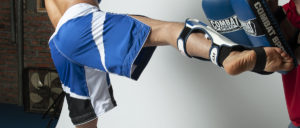
After gloves and hand-wraps, shin guards are the most important piece of protective gear for MMA and Muay Thai fighters.
You use these to protect your shins, ankles, and feet during training. In sparring you’ll also be using them to protect your partner. So it’s important to pick a pair that are right for your needs.
Shin Guard Type
To start, it’s important to note that there are two main types of shin guard in the worlds of MMA and Muay Thai: Sock-Style and Adjustable Strap Style.
Sock-Type Shin Guards
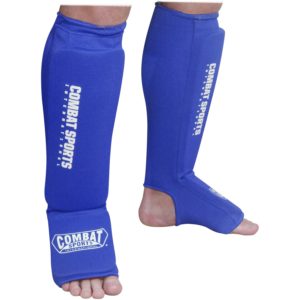 Sock type shin guards typically incorporate a thin, relatively narrow piece of foam over the shin and the foot held together in a stretchy cotton or neoprene sock. Muay Thai fighters may use this type when an amateur fight or tournament requires it, but sock-type guards lack the protection and durability to stand up to long term Muay Thai training.
Sock type shin guards typically incorporate a thin, relatively narrow piece of foam over the shin and the foot held together in a stretchy cotton or neoprene sock. Muay Thai fighters may use this type when an amateur fight or tournament requires it, but sock-type guards lack the protection and durability to stand up to long term Muay Thai training.
While no experienced Muay Thai fighter will use a sock-style guard to train, some MMA fighters prefer the sock-style shin guard for this purpose. Its lighter weight leaves a fighter less encumbered while moving around the ring or grappling. Its lack of exposed edges means that there is less for an opponent to grab onto when you make contact.
These specific factors provide a suitable trade off against decreased protection for a fighter who may not engage in lots of kicks. That being said, for most fighters, it’s best to leave the simple sock style for competitions and focus on the adjustable strap style
Shin Guards with Adjustable Straps
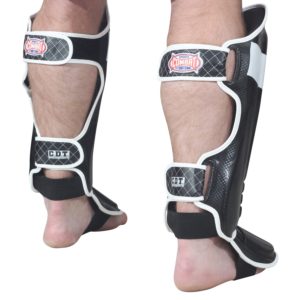 As the name implies, adjustable strap shin guards incorporate a set of adjustable straps to secure semi-rigid, dense padding over the shin, ankle, and the top of the foot. The guard usually includes a strap close to the top, to securely fasten above the curve of the calf. A second strap usually secures to the fighter between the bottom of the calf muscle and the top of the ankle. There will then be a strap that comes across the middle of the foot, completing the fastening system.
As the name implies, adjustable strap shin guards incorporate a set of adjustable straps to secure semi-rigid, dense padding over the shin, ankle, and the top of the foot. The guard usually includes a strap close to the top, to securely fasten above the curve of the calf. A second strap usually secures to the fighter between the bottom of the calf muscle and the top of the ankle. There will then be a strap that comes across the middle of the foot, completing the fastening system.
This style of shin guard represents the overwhelming majority for both MMA and Muay Thai training. This style provides the most protection from injury for both the fighter and any sparring partner the fighter may engage with.
It takes years of practice and conditioning before your shins are fully capable of handling a fight without any protection. Until that time, use proper shin guards so you won’t lose valuable training time to shin, ankle, or foot injuries.
Materials
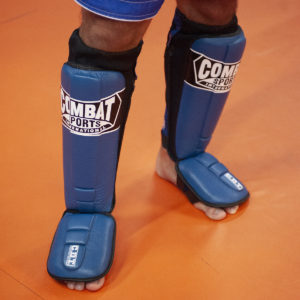
Shin guards that have an authentic leather exterior offer the best long-term performance. Leather is the most durable material you can find and will last a long time under regular use. Leather will also tend to be more expensive than some other available material options.
Polyurethane synthetic leathers are a close second when it comes to top quality products and cost a little less. Not as durable, this type of finish has a leather feel to it and can still last quite a while under normal use.
Vinyl, neoprene, and cotton represent other materials that one might find when looking for shin guards. These types of material lack the durability of Leather and Synthetic Leather, but can be used to produce a much less expensive product.
Sizing
As shown in our size-chart, measure the circumference of your leg at the calf to get an idea of what size you need. You may also want to consider the length of your shin (measured from just above the ankle to just below the knee). Some manufacturers offer guards that are taller or shorter than normal to accommodate people of different size. Measuring the length of your shin will help you ensure a good fit.
Fit
As with gloves and headgear, it is important that the shin guard fit snug, but still be comfortable. If the shin guard pinches or otherwise fits uncomfortably, you should move on to a different set.
One reason that you want this to fit snugly, is to prevent the guard from spinning around or sliding off during training–especially once the sweat starts to pour.
Mobility
The shin guard should not impede normal movement. Your ankles should be able to bend as easily and fully with the guards on as when you wear no guard. Likewise, the shin guard should not extend very far beyond the bottom of the knee. You don’t want the shin guard to protrude into space when your knees are bent. Should check for proper mobility while standing and then executing a few typical ring movements.
Protection
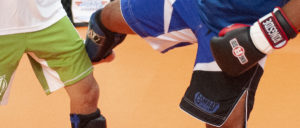
The padding on the front of the shin needs to be rigid and protective with multiple layers of foam. But it should not be so hard that you will injure an opponents during sparring sessions.
Shin guards come in a variety of widths. Some protect just the area over the sensitive shin bone, while others wrap around to cover some of the calf muscle as well. A wider shin guard offers more protection at the cost of additional weight and bulk. It will also provide your opponent more points to grab a hold of. A narrower pad will be lighter, allowing you to kick longer and faster, and less of a liability for grabs and holds. But you will be at greater risk to injury and bruising.
It’s important to make sure your shin guard has proper protection over the entire foot as well. Most of the injuries that will fully sideline you happen in the top bones of the foot. You need to make sure you protect this area during training and the ankle as well.
Other Options
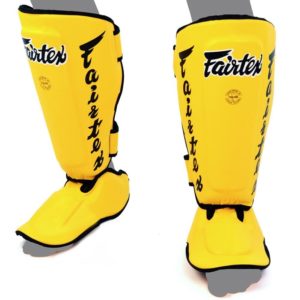
Detachable – Detachable guards use a hook and loop attachment system to provide greater ability to customize the fit and feel of your shin guards. Typically, these are designed to allow the foot and instep pad to shift or be removed completely.
Hybrid Styles – Some manufacturers offer hybrid shin guard options. These styles attempt to combine the protection of Adjustable Strap Shin Guards with the security and ease of use of a sock-style.
Shin Conditioning
While you should definitely use shin guards to protect yourself while hitting the pads and sparring, you will need to build up adequate strength, durability, and pain tolerance in your shins to be able to compete. This process is known as Shin Conditioning.
The simplest way to condition your shin is by kicking a heavy bag, while wearing no protective gear, 50 to 100 times per leg per day. This will toughen the area up. Sparring, both full speed with protective gear on, and slower speeds with no protection on provide opportunities to practice striking and being struck.
Strength training the lower leg with weighted squats and lunges will improve leg durability by strengthening the muscles that support the lower leg.
As you think about buying a pair of shin guards, one final thought in mind. Good shin guards are an investment. If you’re just trying the sport out, and don’t know if you’re sticking with it, then it may make sense to pick up something adequate but cheap. If you’re in this for the long haul, however, purchase something that’s going to last, even if it’s a little more expensive. It will save you money in the long run.
If you still have questions, please reach out to our customer support team at customerservice@combatbrands.com. They are happy to help you learn more.
Also, don’t forget to sign up for our email newsletter if you haven’t already subscribed to get access to more great information like this and great deals on all of our products.



It is difficult to pick up the right and perfect shin guards. They are the many types of shin guards. But I mostly used the adjustable strap style.